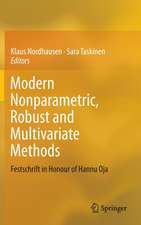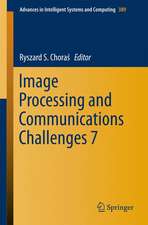Automatic Generation of Morphological Set Recognition Algorithms: Springer Series in Perception Engineering
Autor Robert C. Vogten Limba Engleză Paperback – 22 dec 2011
Preț: 560.98 lei
Preț vechi: 701.23 lei
-20% Nou
Puncte Express: 841
Preț estimativ în valută:
107.36€ • 111.67$ • 88.63£
107.36€ • 111.67$ • 88.63£
Carte tipărită la comandă
Livrare economică 10-16 aprilie
Preluare comenzi: 021 569.72.76
Specificații
ISBN-13: 9781461396543
ISBN-10: 1461396549
Pagini: 284
Ilustrații: V, 275 p.
Dimensiuni: 156 x 244 x 15 mm
Ediția:Softcover reprint of the original 1st ed. 1989
Editura: Springer
Colecția Springer
Seria Springer Series in Perception Engineering
Locul publicării:New York, NY, United States
ISBN-10: 1461396549
Pagini: 284
Ilustrații: V, 275 p.
Dimensiuni: 156 x 244 x 15 mm
Ediția:Softcover reprint of the original 1st ed. 1989
Editura: Springer
Colecția Springer
Seria Springer Series in Perception Engineering
Locul publicării:New York, NY, United States
Public țintă
ResearchCuprins
1 Introduction.- 1.1 Problem Definition and Characterization.- 1.2 Mathematical Morphology.- 1.3 Related Work.- 1.4 Goals and Objectives.- 1.5 Organization of the Book.- 2 Review of Mathematical Morphology.- 2.1 Types of Image Data.- 2.2 Images as Sets in Space.- 2.3 Operation Classes and Properties.- 2.4 Criteria.- 2.5 Set Operations.- 2.6 Positional Masking and Thresholding Operations.- 2.7 Translation-Based Morphology Operations.- 2.8 Structuring Element Decomposition.- 2.9 Common Structuring Elements.- 2.10 Erosions and Dilations.- 2.11 Openings and Closings.- 2.12 Residues.- 2.13 Band Operations.- 2.14 Particle and Hole Operations.- 2.15 Grey Level Operations.- 2.16 Summary of Problem Domain.- 3 Theory of Automatic Set Recognition.- 3.1 Basic Terminology.- 3.2 Example Problems.- 3.3 Formal Description of Problems.- 3.4 Algorithms as Graphs.- 3.5 The Algorithm Development Process.- 3.6 Search Strategies and Completeness.- 4 REM System Implementation.- 4.1 Representation of Algorithms.- 4.2 Overview of System Design.- 4.3 Search Management.- 4.4 Problem Solving.- 4.5 System Output.- 5 Results.- 5.1 Summary of System Capabilities.- 5.2 Examples of Problems Solved by REM.- 5.3 Example Program Run.- 6 Conclusion.- 6.1 Primary Accomplishments.- 6.2 Summary and Discussion.- 6.3 Future Directions.- A Partial List of Example Problems Solved by REM.- B Algebraic Definitions of IC Band Operations.- C Terminal Output for Example Problem ‘TCODSK_RT’.- D Band Operators Defined in the IC Target Language.- E Selected Bibliography.
































